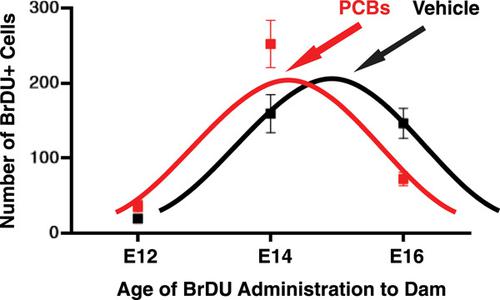当前位置:
X-MOL 学术
›
J. Exp. Zool. Part A
›
论文详情
Our official English website, www.x-mol.net, welcomes your
feedback! (Note: you will need to create a separate account there.)
Exposure to prenatal PCBs shifts the timing of neurogenesis in the hypothalamus of developing rats.
Journal of Experimental Zoology Part A ( IF 1.9 ) Pub Date : 2020-08-15 , DOI: 10.1002/jez.2404 Morgan E Hernandez Scudder 1 , Marcela Nicole Kunkel 2 , Andrea C Gore 1, 3
Journal of Experimental Zoology Part A ( IF 1.9 ) Pub Date : 2020-08-15 , DOI: 10.1002/jez.2404 Morgan E Hernandez Scudder 1 , Marcela Nicole Kunkel 2 , Andrea C Gore 1, 3
Affiliation

|
The developing brain is highly sensitive to the hormonal milieu, with gonadal steroid hormones involved in neurogenesis, neural survival, and brain organization. Limited available evidence suggests that endocrine‐disrupting chemicals (EDCs) may perturb these developmental processes. In this study, we tested the hypothesis that prenatal exposure to a mixture of polychlorinated biphenyls (PCBs), Aroclor 1221, would disrupt the normal timing of neurogenesis in two hypothalamic regions: the ventromedial nucleus (VMN) and the preoptic area (POA). These regions were selected because of their important roles in the control of sociosexual behaviors that are perturbed in adulthood by prenatal EDC exposure. Pregnant Sprague–Dawley rats were exposed to PCBs from Embryonic Day 8 (E8) to E18, encompassing the period of neurogenesis of all hypothalamic neurons. To determine the birth dates of neurons, bromo‐2‐deoxy‐5‐uridine (BrdU) was administered to dams on E12, E14, or E16. On the day after birth, male and female pups were perfused, brains immunolabeled for BrdU, and numbers of cells counted. In the VMN, exposure to PCBs significantly advanced the timing of neurogenesis compared to vehicle‐treated pups, without changing the total number of BrdU+ cells. In the POA, PCBs did not change the timing of neurogenesis nor the total number of cells born. This is the first study to show that PCBs can shift the timing of neurogenesis in the hypothalamus, specifically in the VMN but not the POA. This result has implications for functions controlled by the VMN, especially sociosexual behaviors, as well as for sexual selection more generally.
中文翻译:

暴露于产前 PCB 会改变发育大鼠下丘脑神经发生的时间。
发育中的大脑对荷尔蒙环境高度敏感,性腺类固醇激素参与神经发生、神经存活和大脑组织。有限的现有证据表明,内分泌干扰化学物质 (EDC) 可能会扰乱这些发育过程。在这项研究中,我们检验了以下假设:产前接触多氯联苯 (PCB) 的混合物 Aroclor 1221 会破坏下丘脑两个区域的正常神经发生时间:腹内侧核 (VMN) 和视前区 (POA)。之所以选择这些区域,是因为它们在控制成年期因产前 EDC 暴露而受到干扰的社会性行为方面具有重要作用。从胚胎第 8 天 (E8) 到 E18,怀孕的 Sprague-Dawley 大鼠暴露于 PCBs,包括所有下丘脑神经元的神经发生期。为了确定神经元的出生日期,在 E12、E14 或 E16 时将溴-2-脱氧-5-尿苷 (BrdU) 施用于水坝。在出生后的第二天,对雄性和雌性幼崽进行灌注,对大脑进行 BrdU 免疫标记,并对细胞数量进行计数。在 VMN 中,与载体处理的幼崽相比,暴露于 PCB 显着提前了神经发生的时间,而不会改变 BrdU+ 细胞的总数。在 POA 中,PCB 没有改变神经发生的时间,也没有改变出生的细胞总数。这是第一项表明 PCB 可以改变下丘脑神经发生时间的研究,特别是在 VMN 而不是 POA。这一结果对 VMN 控制的功能有影响,尤其是社会性行为,以及更普遍的性选择。溴-2-脱氧-5-尿苷(BrdU)在 E12、E14 或 E16 被施用于水坝。在出生后的第二天,对雄性和雌性幼崽进行灌注,对大脑进行 BrdU 免疫标记,并对细胞数量进行计数。在 VMN 中,与载体处理的幼崽相比,暴露于 PCB 显着提前了神经发生的时间,而不会改变 BrdU+ 细胞的总数。在 POA 中,PCB 没有改变神经发生的时间,也没有改变出生的细胞总数。这是第一项表明 PCB 可以改变下丘脑神经发生时间的研究,特别是在 VMN 而不是 POA。这一结果对 VMN 控制的功能有影响,尤其是社会性行为,以及更普遍的性选择。溴-2-脱氧-5-尿苷(BrdU)在 E12、E14 或 E16 被施用于水坝。在出生后的第二天,对雄性和雌性幼崽进行灌注,对大脑进行 BrdU 免疫标记,并对细胞数量进行计数。在 VMN 中,与载体处理的幼崽相比,暴露于 PCB 显着提前了神经发生的时间,而不会改变 BrdU+ 细胞的总数。在 POA 中,PCB 没有改变神经发生的时间,也没有改变出生的细胞总数。这是第一项表明 PCB 可以改变下丘脑神经发生时间的研究,特别是在 VMN 而不是 POA。这一结果对 VMN 控制的功能有影响,尤其是社会性行为,以及更普遍的性选择。对 BrdU 进行免疫标记的大脑,并计算细胞数量。在 VMN 中,与载体处理的幼崽相比,暴露于 PCB 显着提前了神经发生的时间,而不会改变 BrdU+ 细胞的总数。在 POA 中,PCB 没有改变神经发生的时间,也没有改变出生的细胞总数。这是第一项表明 PCB 可以改变下丘脑神经发生时间的研究,特别是在 VMN 而不是 POA。这一结果对 VMN 控制的功能有影响,尤其是社会性行为,以及更普遍的性选择。对 BrdU 进行免疫标记的大脑,并计算细胞数量。在 VMN 中,与载体处理的幼崽相比,暴露于 PCB 显着提前了神经发生的时间,而不会改变 BrdU+ 细胞的总数。在 POA 中,PCB 没有改变神经发生的时间,也没有改变出生的细胞总数。这是第一项表明 PCB 可以改变下丘脑神经发生时间的研究,特别是在 VMN 而不是 POA。这一结果对 VMN 控制的功能有影响,尤其是社会性行为,以及更普遍的性选择。PCB 没有改变神经发生的时间,也没有改变出生的细胞总数。这是第一项表明 PCB 可以改变下丘脑神经发生时间的研究,特别是在 VMN 而不是 POA。这一结果对 VMN 控制的功能有影响,尤其是社会性行为,以及更普遍的性选择。PCB 没有改变神经发生的时间,也没有改变出生的细胞总数。这是第一项表明 PCB 可以改变下丘脑神经发生时间的研究,特别是在 VMN 而不是 POA。这一结果对 VMN 控制的功能有影响,尤其是社会性行为,以及更普遍的性选择。
更新日期:2020-08-15
中文翻译:

暴露于产前 PCB 会改变发育大鼠下丘脑神经发生的时间。
发育中的大脑对荷尔蒙环境高度敏感,性腺类固醇激素参与神经发生、神经存活和大脑组织。有限的现有证据表明,内分泌干扰化学物质 (EDC) 可能会扰乱这些发育过程。在这项研究中,我们检验了以下假设:产前接触多氯联苯 (PCB) 的混合物 Aroclor 1221 会破坏下丘脑两个区域的正常神经发生时间:腹内侧核 (VMN) 和视前区 (POA)。之所以选择这些区域,是因为它们在控制成年期因产前 EDC 暴露而受到干扰的社会性行为方面具有重要作用。从胚胎第 8 天 (E8) 到 E18,怀孕的 Sprague-Dawley 大鼠暴露于 PCBs,包括所有下丘脑神经元的神经发生期。为了确定神经元的出生日期,在 E12、E14 或 E16 时将溴-2-脱氧-5-尿苷 (BrdU) 施用于水坝。在出生后的第二天,对雄性和雌性幼崽进行灌注,对大脑进行 BrdU 免疫标记,并对细胞数量进行计数。在 VMN 中,与载体处理的幼崽相比,暴露于 PCB 显着提前了神经发生的时间,而不会改变 BrdU+ 细胞的总数。在 POA 中,PCB 没有改变神经发生的时间,也没有改变出生的细胞总数。这是第一项表明 PCB 可以改变下丘脑神经发生时间的研究,特别是在 VMN 而不是 POA。这一结果对 VMN 控制的功能有影响,尤其是社会性行为,以及更普遍的性选择。溴-2-脱氧-5-尿苷(BrdU)在 E12、E14 或 E16 被施用于水坝。在出生后的第二天,对雄性和雌性幼崽进行灌注,对大脑进行 BrdU 免疫标记,并对细胞数量进行计数。在 VMN 中,与载体处理的幼崽相比,暴露于 PCB 显着提前了神经发生的时间,而不会改变 BrdU+ 细胞的总数。在 POA 中,PCB 没有改变神经发生的时间,也没有改变出生的细胞总数。这是第一项表明 PCB 可以改变下丘脑神经发生时间的研究,特别是在 VMN 而不是 POA。这一结果对 VMN 控制的功能有影响,尤其是社会性行为,以及更普遍的性选择。溴-2-脱氧-5-尿苷(BrdU)在 E12、E14 或 E16 被施用于水坝。在出生后的第二天,对雄性和雌性幼崽进行灌注,对大脑进行 BrdU 免疫标记,并对细胞数量进行计数。在 VMN 中,与载体处理的幼崽相比,暴露于 PCB 显着提前了神经发生的时间,而不会改变 BrdU+ 细胞的总数。在 POA 中,PCB 没有改变神经发生的时间,也没有改变出生的细胞总数。这是第一项表明 PCB 可以改变下丘脑神经发生时间的研究,特别是在 VMN 而不是 POA。这一结果对 VMN 控制的功能有影响,尤其是社会性行为,以及更普遍的性选择。对 BrdU 进行免疫标记的大脑,并计算细胞数量。在 VMN 中,与载体处理的幼崽相比,暴露于 PCB 显着提前了神经发生的时间,而不会改变 BrdU+ 细胞的总数。在 POA 中,PCB 没有改变神经发生的时间,也没有改变出生的细胞总数。这是第一项表明 PCB 可以改变下丘脑神经发生时间的研究,特别是在 VMN 而不是 POA。这一结果对 VMN 控制的功能有影响,尤其是社会性行为,以及更普遍的性选择。对 BrdU 进行免疫标记的大脑,并计算细胞数量。在 VMN 中,与载体处理的幼崽相比,暴露于 PCB 显着提前了神经发生的时间,而不会改变 BrdU+ 细胞的总数。在 POA 中,PCB 没有改变神经发生的时间,也没有改变出生的细胞总数。这是第一项表明 PCB 可以改变下丘脑神经发生时间的研究,特别是在 VMN 而不是 POA。这一结果对 VMN 控制的功能有影响,尤其是社会性行为,以及更普遍的性选择。PCB 没有改变神经发生的时间,也没有改变出生的细胞总数。这是第一项表明 PCB 可以改变下丘脑神经发生时间的研究,特别是在 VMN 而不是 POA。这一结果对 VMN 控制的功能有影响,尤其是社会性行为,以及更普遍的性选择。PCB 没有改变神经发生的时间,也没有改变出生的细胞总数。这是第一项表明 PCB 可以改变下丘脑神经发生时间的研究,特别是在 VMN 而不是 POA。这一结果对 VMN 控制的功能有影响,尤其是社会性行为,以及更普遍的性选择。











































 京公网安备 11010802027423号
京公网安备 11010802027423号